Unlocking the Fishing Food Chain – Part 1
Everyone has heard of the food chain. Sam Mossman explains how anglers can exploit it to their advantage.
The original form of this poem was, I think, about fleas, but the concept of the food chain is just the same in the world’s oceans. There are a wide range of trophic levels in the web of life and they are not always what you would expect. For example, sometimes the largest animals (like baleen whales, giant manta rays and whale sharks) eat the smallest – the sunlight-generated phytoplankton (the ‘plants’ of the sea). In other links of the food chain, predators like orca are known to attack whales larger than they are.
Many of the fish that anglers like to catch and eat are at least three or four tropic levels from the base. Some examples are: phytoplankton-zooplankton (tiny ‘animals’)-pilchards-kingfish; and phytoplankton-shellfish-snapper. Sometimes food chains are more compact: trevally may feed directly on plankton; or longer: phytoplankton-zooplankton-mackerel-tuna-marlin.
But no matter what the angler is trying to catch, for best results they need to insert themselves into the existing food chain. It can be oddly satisfying to start at the bottom end of the chain and make something out of nothing.
Dory dinners
Some years ago, I had the opportunity to deckie for a pioneering American saltwater fisherman, the late Billy Pate, when he visited this country on his international quest to catch record marlin on saltwater fly. (Despite a brief hook up, Billy was unsuccessful here.)
For this exercise we were based in Pukenui on the Houhora Harbour and after the rest of the team was settled into the motel, I wandered down to the wharf with a rod, and in a plastic bag, a sabiki, a spool of trace material, a couple of hooks and a sinker. I tied up a ledger rig and put it aside, then snapped the sabiki onto the end of my line. I could see baitfish in the water and hooked a small yelloweye mullet. Not quite what I wanted as a bait, so I cut some small strip-baits off it and added this to the sabiki flies. That did the trick and I soon had a jack mackerel on the wharf. I quickly changed the sabiki for the ledger rig, hooked up the jack as a livebait and flicked it into the channel. I did not have to wait long before a john dory sucked it down and was itself hauled up onto the wharf. After repeating the process, I wandered happily back to my room with a couple of delicious dinners.
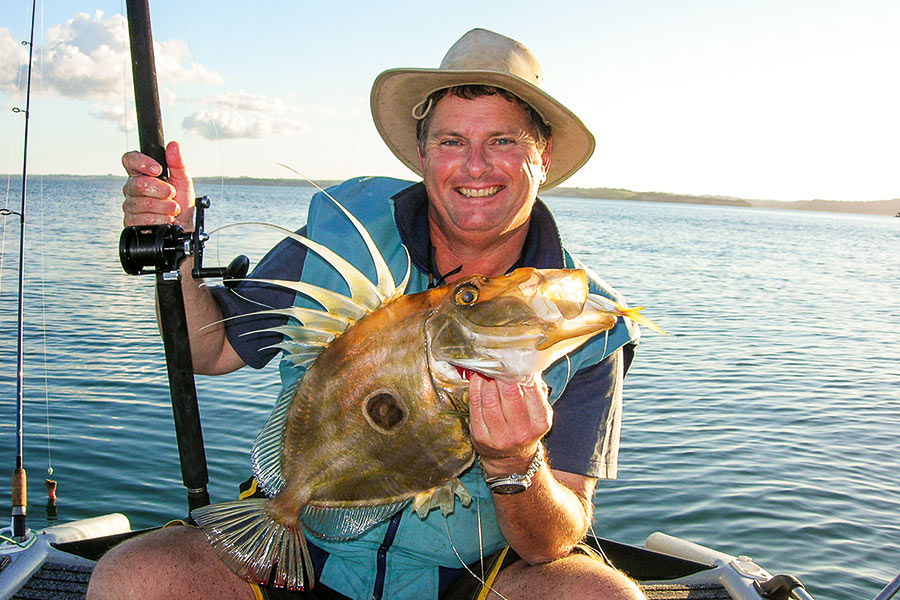
Fishing up the food chain can provide a tasty dinner, such as this john dory.
Down on the farm
Going back even further to my years working in earth sciences, I spent one summer doing the fieldwork for a water resources survey at Great Barrier Island in the Hauraki Gulf. My workmate and I found that if we started work at dawn, we could finish the day’s work by 3pm and so create a few free hours in the late afternoon. The lodge we were staying at was kind enough to loan me their two-metre pram dinghy and with a light spin rod I had toted out to the island and a few basic items of terminal tackle, I rowed across the bay to a mussel farm to try my hand at catching dinner. Each mussel float seemed to have the nose of a kingfish poking out from underneath, but how to catch one?
The mussel farm owners at the time were quite happy for me to pluck a few mussels from the lines for bait, but the kings would have none of them. A livebait would do the trick, I knew, but although I had a single string of sabiki flies, I did not even have a bucket to keep a baitfish alive in while I changed the rig on my one and only rod. I tied a snap-swivel onto the end of my leader, clipped my sabiki onto it and lowered it to the bottom, where I soon hooked a jack mackerel. Cranking the little fish quickly to the boat, I quickly unsnapped the sabiki and replaced it with a beak hook, which I slipped through the scruff of the mackerel’s neck.
I dropped the livebait into the water beside my little boat and it was immediately scoffed by a kingfish. That is where the fun began, of course, with mussel lines and ropes everywhere and a cover-hunting kingfish, although of modest size, hooked on a light spin rod and six-kilo line from a small single-handed rowboat. Rowing and winding by turns and sliding the boat under mussel lines I somehow managed to avoid being cut off and eventually subdued the kingfish before lifting it into the boat. I was as proud of that fish as any I had caught and it fed us for the rest of the week, allowing our government meal allowances to go straight into the bank!

Rigging jack mackerel livebait for a kingfish.
Sabikis a key
As you can deduce, sabikis are an important key to exploiting the food chain, producing baitfish which, in turn, can provide table fish. This is not the only way to start, of course. The feed sources of many fish species include shellfish, crabs and other benthic creatures. Using such creatures as bait can allow you to target fish seldom caught on cut fish baits – species like blue moki, parore and spotted dogfish – while still leaving you in the hunt for desirables like snapper, tarakihi and trevally. And, usefully, these baits can often be foraged for on the spot.
Several years ago, a friend, Antony, and I were camping at a remote area of the Kaipara Harbour, doing a little surfcasting. We were having a great time but catching mostly stingrays and undersized snapper. It was getting to the stage, on our last day, where we really needed to catch something to eat. While I persisted in losing cut baits to fish species we didn’t want, Antony had a rummage in a rock pool and found a large crab. Impaling it on his hook, he cast it out and it was quickly hooked up to a spotted dogfish, a species particularly partial to a feed of crab. Anything that lives on crabs (flounder are another example) normally tastes pretty good and it was not long before the spotty was filleted and in the camp oven over the embers, making a fine late breakfast.
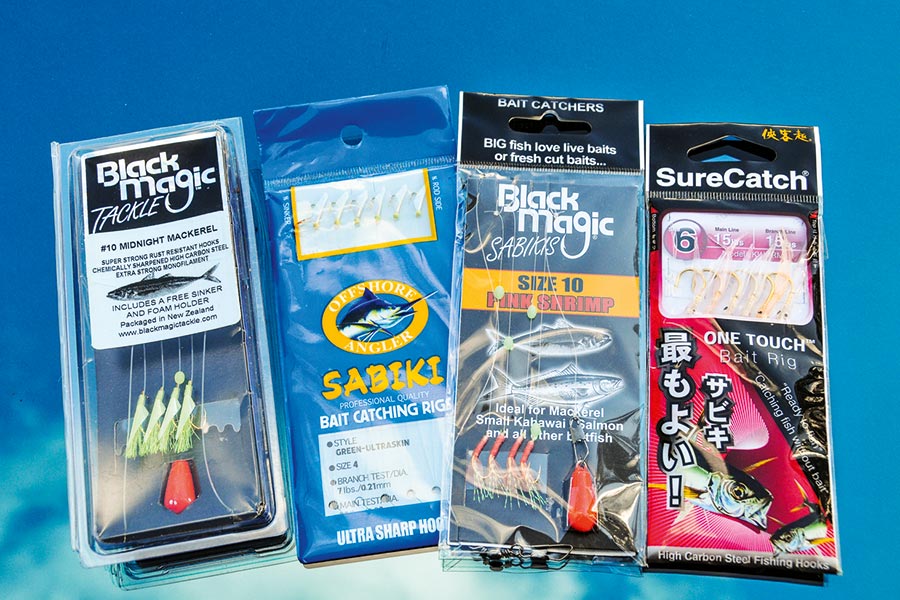
Sabikis are a great device to let anglers into the food chain.
Everything loves skipjack
And then there is what I like to think of as ‘the universal bait’ – skipjack tuna. Sometimes wrongly called ‘bonito’, these small tuna are usually found north of Cook Strait. They are considered an offshore species, but not always. I have caught them as close in as around the Hauraki Gulf’s Noises Islands and seen them just off Auckland’s Castor Bay, and not far offshore in the Bay of Islands and the Coromandel Peninsula. Several years ago, I even caught one just off Houhora while soft-baiting for snapper in just 16m of water.
Skipjack are a second useful key to the food chain. They are prized for their quality as bait and it always pays to keep an eye out for a chance to harvest some. When game fishing, skipjack are used as livebaits, pitch baits or skip baits and are one of the best marlin baits going. Makos also love them and we have caught several monster yellowfin tuna on them, too. If you find some warm oceanic water with plenty of life, catch a skipjack, bridle rig it and slow troll it – some exciting things are likely to happen. The belly flaps can be sewn into great troll baits, too
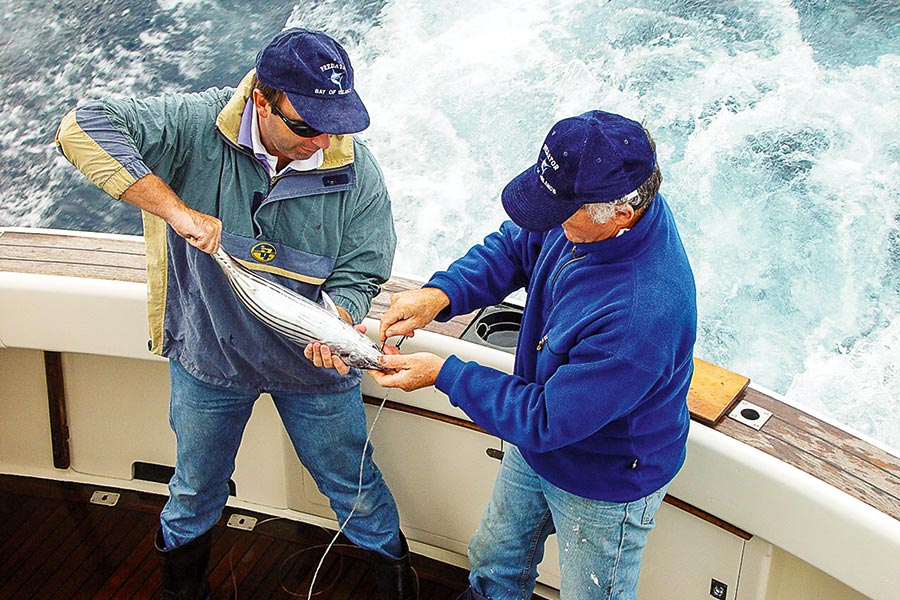
Bridle rigging skipjack is a great way to catch marlin.
Skippy is also my all-time favourite cut bait for stray-lining and bottom fishing. This is largely because the high oil content of the flesh puts out a heavy scent trail that more-or-less yells “HERE BE SERIOUS CALORIES!” bringing in fish from a long way away. Most fish find it hard to resist such a rich food source, sometimes even those species that are not regular eaters of flesh. A mate caught a silver drummer on skipjack bait once. Another advantage is the flashing silver colour of much of the skin, which provides a good visual attraction.
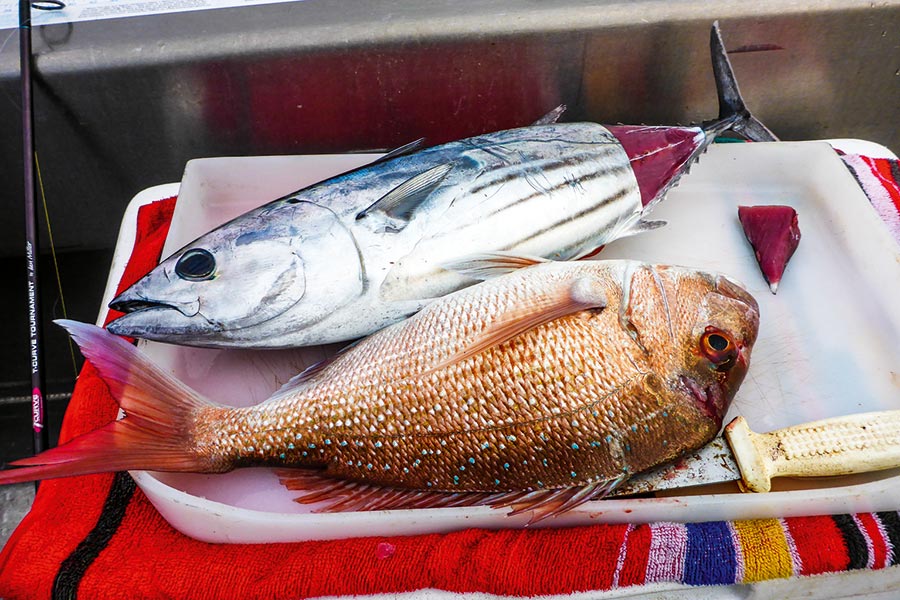
Everything loves a skipjack, especially snapper.
Skipjack flesh can get mushy after a while and the best way to treat it is to cut it down into either fillets or bait-sized pieces and pack it down into plastic containers with a sprinkling of salt between each layer of bait. Let it sit in a cool spot for a day or two then pop it in the bait freezer, where it will keep indefinitely. The salt toughens it up, too, so it stays on the hook better.
If purely harvesting skipjack for bait, I like to use a heavy handline with a bungie insert to take the shock of the strike. Small pink and white feathers or skirts around 100mm long are very effective.

Using a bungee line and a small pink skirted troll lure is an efficient way to harvest skipjack.
Skipjack can be caught in a number of ways and trolling small lures is a favourite. As mentioned, small pink skirted lures or feathers have been very effective for me over the years and similar lures in purple and black, white and red, and plain white can also be excellent, as can lime-yellow-orange (‘zucchini’). Other colours have their day, too. Keeping the lure small and the hooks strong are the important bits.
Trolling is not the only way to catch skippies. I have taken them casting flies, spinning with small metal lures (a reel with a very fast retrieve is important for this), cubing and even on small jack mackerel livebaits, bringing the two branches of our food chain back together.
A fisherman with a freezer full of salted skipjack is a happy chap, indeed.

Happy is the fisherman with a freezer full of skipjack and in this case, several bonus Manukau mahimahi as well.
|
|
This article is reproduced with permission of |
Recent Posts Visit Forum
SMUDGE
in The Briny Bar5 hours ago
rowboat bob
Hey Smudge, I've never met you, but you seem like a good bloke . Thanks for all your work on this site. Happy birthday and have...

POPPING VANUATU
in Popper and Topwater Fishing5 hours ago
FarmerBrowne
Halco Rooster Poppers and River to Sea Dumbell poppers are also commonly used and effective where I mostly fish now days (Aitutaki). I personally find the...

Spammers Beware!
in Forum comments and feedback7 hours ago
Pcj
How does it keep getting through??Edit Grunta: All gone Paul - I've removed the links as they don't go anywhere but thanks for the heads-upThe reality...

Auckland Yakkers
in Yak Yak Yak7 hours ago
Hard Yakker
The birds were at Campbells today, yes all of the birds, I've never seen so many birds. It was a hot session, and surely a bad...
What I Bought Today
in T.A.S (Tackle Acquisition Syndrome)12 hours ago
Mc Tool
I used to manage a service dept for a nationwide department store , and once I got my head around stock control I was gobsmacked at ...
Popular Articles

Softbait Fishing - Part 1 - gear selection
John Eichlesheim writes an article about selecting the right equipment for softbait fishing... Read More >
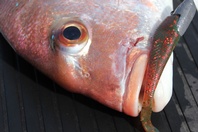
Softbait fishing Pt 2 - tips and tricks
Techniques, tips and tricks of softbait fishing – getting the most from your soft baits.... Read More >

Surfcasting - setting yourself up
Gary Kemsley helps sort out the necessary gear for intending surf fishers.... Read More >

Squid - How to catch them
Squid fishing is a rapidly growing aspect of fishing - Paul Senior shares some hints and tips to get started.... Read More >
Fishing Reports Visit Reports
Bream Bay Fishing Report - 18/04/24
Change in seasons, change in tactics Not a lot to report in the ‘big fish’... Read More >
Canterbury Fishing Report - 04/04/24
Fish galore! Coming off the back of Easter Weekend and with some very nice weather... Read More >
Raglan Fishing Report - 04/04/24
Excellent snapper action There is some excellent autumn snapper fishing straight out and up the... Read More >
Bream Bay Fishing Report - 04/04/24
Whangarei Harbour fishing well Like the weather, the fishing has been patchy throughout Bream Bay... Read More >


Comments